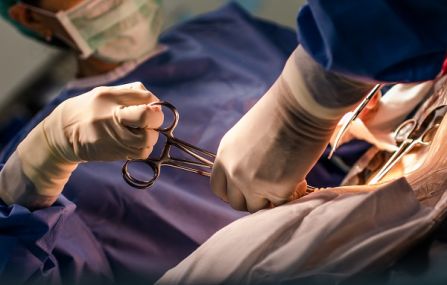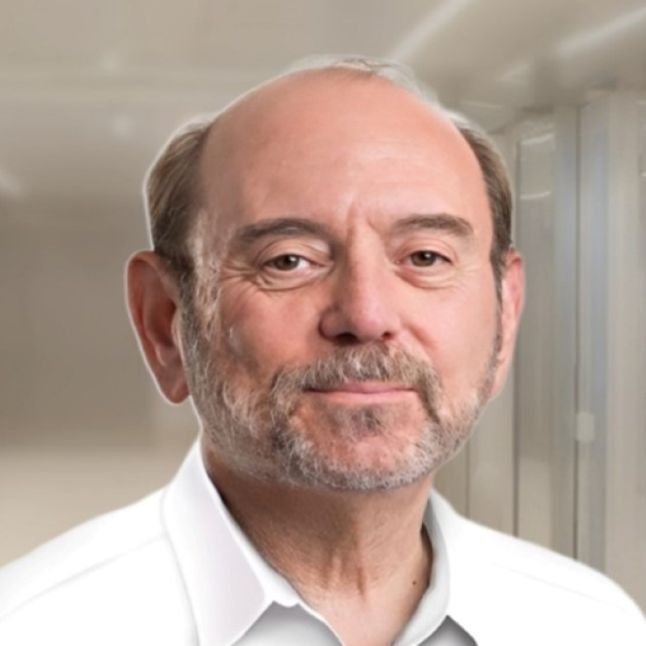 Gynecology is a specialized field dealing with diseases of the female reproductive organs and their treatment. Certain gynecological problems can only be treated surgically. Gynecological surgeries are always preceded by a specialist examination, and in justified cases, additional laboratory and imaging procedures as well. Regular gynecological screening is essential for diagnosing often asymptomatic alterations. Early detection of these gynecological problems is a crucial condition for effective treatment.
Gynecology is a specialized field dealing with diseases of the female reproductive organs and their treatment. Certain gynecological problems can only be treated surgically. Gynecological surgeries are always preceded by a specialist examination, and in justified cases, additional laboratory and imaging procedures as well. Regular gynecological screening is essential for diagnosing often asymptomatic alterations. Early detection of these gynecological problems is a crucial condition for effective treatment.
Please select the area related to your problem from the drop-down menu and click for more details!
Types of gynecological surgeries:
Depending on the type of problem, gynecological surgeries can be performed in different surgical modes. Some can be performed through a small incision or body opening using an optical instrument, the endoscope, which allows observation of the surgical site within the body through a camera. The image captured by the camera is projected onto a monitor. On the other hand, certain gynecological problems require open abdominal surgery. All types of gynecological interventions are always preceded by a gynecological consultation combined with examinations. During this, the gynecologist suggests a surgical solution based on the established diagnosis - if medication is not sufficient. If the surgery is to be performed under anesthesia, a consultation with an anesthesiologist is required prior to the surgery, most often knowing the results of blood tests, chest x-rays, and EKG.
Laparoscopic surgeries
Laparoscopic surgeries represent a branch of endoscopy where therapeutic interventions take place in the abdominal cavity.
During the surgery, special tools can be guided into the abdominal cavity through a few centimeters incisions, and the surgeon navigates with the help of the inserted camera and light source. The advantage of this procedure is that compared to surgeries involving abdominal incisions, it imposes a smaller surgical load, and it is characterized by
- a more pleasing cosmetic result (small, barely noticeable scars),
- less pain and bleeding after the surgery,
- a lower frequency and degree of scarring, and
- a shorter hospital stay and quicker recovery.
It can be applied, for example, in the removal of cysts, the surgical solution of ectopic pregnancy, or the removal of the ovary, fallopian tube, uterus, or myoma.
Laparoscopic surgeries are performed under anesthesia and generally, you can leave the hospital within a few days after the intervention, in some cases even on the same day.
Preparation
Depending on the type of laparoscopic surgery, you should not consume food or drink in the 6-12 hours preceding the surgery. If the patient is taking anticoagulants (e.g. aspirin, warfarin), these usually need to be discontinued a few days before surgery to avoid major bleeding during the operation. If you smoke, it is recommended to quit smoking a few weeks before and after the surgery, as the substances entering the body from cigarette smoke hinder wound healing and predispose to certain complications, such as infections.
Procedure
During laparoscopic surgery, the surgeon makes a few incisions, each 1-2 cm in diameter, in the abdominal wall. Through the first incision, a tube is led into the abdominal cavity, through which the abdomen is inflated with carbon dioxide gas. This ensures excellent visibility and better accessibility to the organs during surgery.
After inflating the abdominal cavity, a camera and special laparoscopic surgical tools are introduced into the abdomen. The image from the camera is projected onto a monitor, allowing the surgeon to see the area to be operated on clearly. With the help of small laparoscopic tools, surgical solutions for the detected abnormalities can be immediately implemented.
Recovery
After waking up from anesthesia, you may feel drowsy, dizzy, and nauseous, which are known and common side effects of anesthetics, and they usually quickly disappear.
After surgery, we monitor our patients, at least until the first urine appears and the patient is able to eat and drink.
A few hours after observation - if the patient's well-being is already good - a nurse will explain and show in detail how to keep the wound clean. Stitches are usually removed and a control examination is scheduled 6-10 days after surgery.
In the first few days after surgery, discomfort and pain around the incisions are normal and can be alleviated or even eliminated by painkillers (e.g. ibuprofen-based preparations) taken as directed by your doctor. A scratching sensation in the throat may be present for a few days due to the intubation tube used during anesthesia.
Some of the gas used to inflate the abdominal cavity can remain inside, causing bloating, cramps, and pain radiating to the shoulder. You do not need to worry about these symptoms, as they do not cause any harm to the body and usually disappear within a day (the remaining gas is absorbed during this time).
In the days and weeks after surgery, you may feel tired and exhausted, as the recovery process consumes a lot of energy. Take breaks and rest multiple times a day if you feel tired. Only return to work when you feel strong enough.
Hysteroscopic (uterine mirror) surgeries
Hysteroscopy is a branch of endoscopy that examines the uterine cavity. During the procedure, a tiny optical device is inserted through the vagina and then through the cervical canal into the uterine cavity, providing reliable information about intrauterine changes and the shape of the uterus.
The procedure can be performed within the framework of a one-day surgical procedure, under general anesthesia or sedation.
With the help of a hysteroscope, we can also insert special instruments into the uterus, which allows us to painlessly take tissue samples in case of suspected tumors, and minor interventions such as polyps, fibroids, or the removal of the endometrium can also be performed.
Hysteroscopy, or uterine examination, is a gynecological intervention that allows for a thorough examination of the uterine cavity and the opportunity to address any abnormalities found at the same time.
The examination is performed using a special instrument (hysteroscope), which is a thin, long metal device with a camera and light source at the end. The image captured by the camera is projected onto a monitor, giving the doctor a perfect view of the uterus's cavity and walls.
The great advantage of hysteroscopy is that there is no need for incision to access the uterine cavity, as the hysteroscope is inserted through the vagina and the cervix. However, in some cases, depending on the abnormalities found, the operation can be extended with the help of laparoscopy (abdominal mirror examination) or laparotomy (abdominal incision) for the most perfect surgical solution of the disease. Patients are always informed about this possibility in advance and in a personalized way, and their consent is requested.
What exactly can hysteroscopy be used for?
- To investigate the cause of various symptoms and complaints, such as: heavy menstrual bleeding, unusual vaginal bleeding, postmenopausal vaginal bleeding, lower abdominal/pelvic pain, recurrent miscarriage, difficulties in getting pregnant.
- To diagnose certain conditions: fibroids, polyps (which are benign tumors of the uterus).
- To treat the abnormalities found: polyps, fibroids, removal of misplaced contraceptive spirals; resolving intrauterine adhesions (also known as adhesion or scar tissue, which can cause missed menstruation and infertility).
Hysteroscopy is used in roughly the same cases as curettage (medical curettage/uterine scraping), but today we prefer modern hysteroscopic techniques, as in this case a camera assists in accurate diagnosis and the accuracy of treatment reduces the frequency of complications.
How is hysteroscopy performed?
Hysteroscopic interventions are usually performed as part of one-day care, so there is no need to stay overnight in the hospital.
During the procedure, there is usually no need for general anesthesia or spinal anesthesia, only local anesthesia of the cervix by injection. If therapeutic intervention is also performed in addition to the diagnostic procedure, general anesthesia is required.
During hysteroscopy:
- the patient lies on an operating table similar to a gynecological examination chair
- the vagina is exposed using a speculum, just like during a regular gynecological examination, e.g., during a cancer screening sample collection
- the hysteroscope is inserted into the uterine cavity through the vagina and cervix, then filled with water to get a clearer image
- with the help of the image transmitted to the monitor by the camera, we thoroughly examine the uterine cavity and walls
- any abnormalities found are also treated at the same time, in this case, fine surgical instruments are inserted through the vagina and cervix, which can be used to remove fibroids, polyps, etc.
Diagnostic hysteroscopy usually does not take longer than 10 minutes, and if treatment is also required, it usually takes about 30 minutes.
In some cases, a sample is taken from the abnormality found, which is called a biopsy. The removed tissue sample is sent for histological examination, thereby further increasing the accuracy of the diagnosis.
During the intervention, a sensation similar to menstrual pain or cramps may occur, but no greater pain should be expected. A painkiller taken before surgery (e.g., paracetamol) can help eliminate discomfort.
After the operation, you can return home following a brief observation, if you are symptom-free. The patient can return to their usual daily activities on the same day if local anesthesia was used. If general anesthesia was used, a 1-2 day rest period is recommended.
Preparation for the Procedure
In the days/weeks before the hysteroscopy, it is advisable to pay attention to the following:
- Several tests are needed before the procedure to determine if the patient is suitable for hysteroscopy, such as a blood test and pregnancy test.
- Use reliable birth control methods, as hysteroscopy cannot be performed during pregnancy.
- Quitting smoking is advised, especially if the procedure will be performed under general anesthesia, as this can reduce the risks associated with anesthesia.
- Drug treatment is usually required before polyp removal to reduce the size of the polyps.
- If the procedure is performed under general anesthesia, you should not eat or drink for the previous 8-12 hours. If the procedure is performed without anesthesia or with local anesthesia, you can eat and drink as you usually do.
What could be the possible complications of hysteroscopy?
Hysteroscopy is generally a very safe procedure - but like any medical procedure - it can have complications, such as:
- Uterine wall injury: Although very rare even when the procedure is performed with the greatest expertise, it can be treated with antibiotics or surgical sutures.
- Cervical injury: Also very rare and can be easily corrected at the time of injury.
- Significant bleeding during or after the procedure: This is a very rare complication that usually occurs during a procedure performed under general anesthesia and can be managed with medication or surgically. In very rare cases, a hysterectomy may be needed for uncontrollable bleeding.
- Infection, inflammation in the uterine cavity: This can cause foul-smelling vaginal discharge, fever, and bleeding, and is treated with antibiotics.
- Dizziness: This occurs once in every 200 women for whom the procedure is performed without anesthesia or with local anesthesia.
How does the recovery process go?
After returning home, at least rest for the day is advised. If the surgery was performed under general anesthesia, you should not drive a vehicle or consume alcohol for the next 24 hours. In such cases, it is best if a family member or friend stays with the patient for the next 24 hours - until the effects of the anesthetic have completely worn off.
During recovery, you may experience:
- menstrual cramp-like pain: it usually disappears within a few days, until then you can take pain relievers as prescribed by your doctor (e.g., paracetamol or ibuprofen-containing products)
- spotting or slightly more bleeding: this can last for 7-10 days, during which it is recommended to use pads instead of tampons to prevent infection of the uterus
The above symptoms are known side effects of the procedure. However, if any of the following complaints occur, seek medical attention as soon as possible:
- severe pain that does not go away with painkillers
- heavy bleeding, which is stronger than menstrual bleeding and/or requires frequent pad changes
- fresh, bright red blood and/or large amounts of blood clots coming out of the vagina
- foul-smelling vaginal discharge
- Fever above 38°C
The time to return to work varies individually, everyone knows their own limits and needs. Some can return to their everyday rhythm the day after hysteroscopy, but some people need a few days of rest, especially if the surgery involved the removal of polyps or fibroids and/or anesthesia.
In general, the following can be said:
- after the procedure - as soon as the patient wishes - you can eat and drink right away, although it is recommended to start with easily digestible foods
- you can take a shower on the same day, but you should avoid baths for a few days
- sexual intercourse is not recommended within a week after the procedure, to avoid infection
If a histological examination was also performed on the tissues taken during the surgery, the result will arrive within a few weeks. Based on this report, you can discuss further steps with your treating physician.
Open Abdominal Surgeries
Certain types of problems necessitate the execution of open abdominal surgery.

















